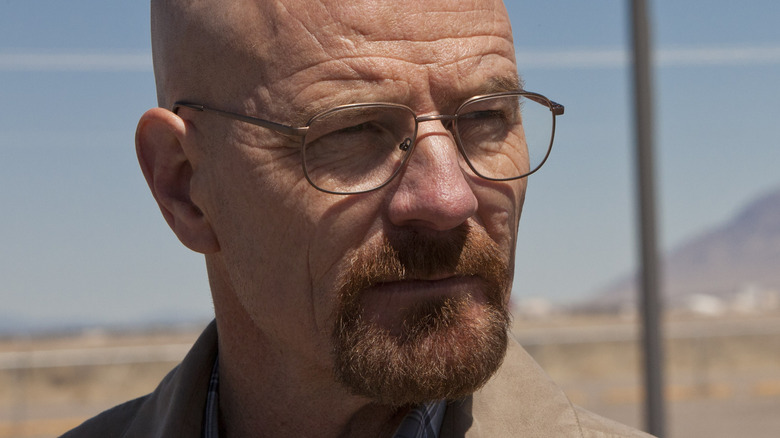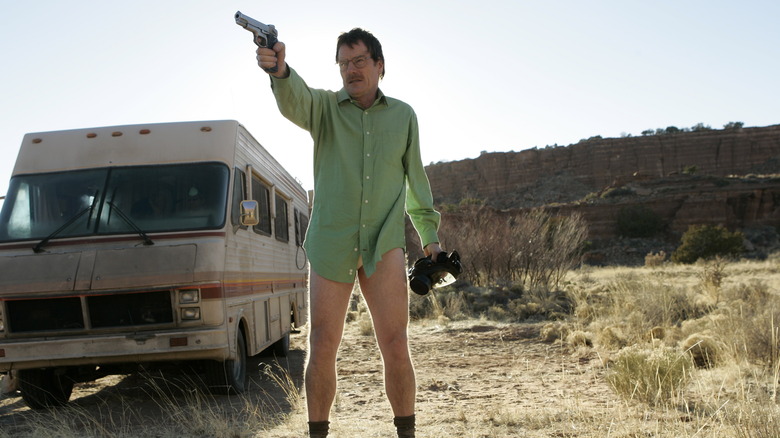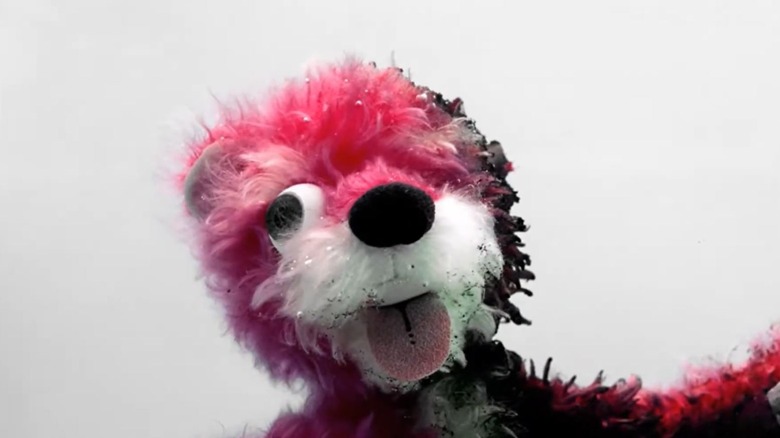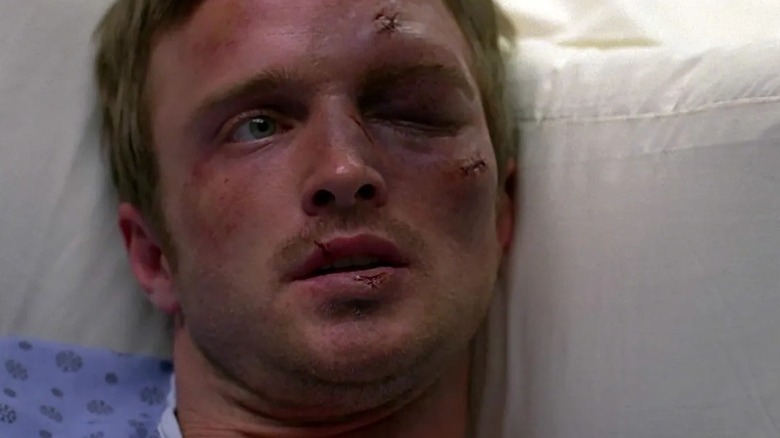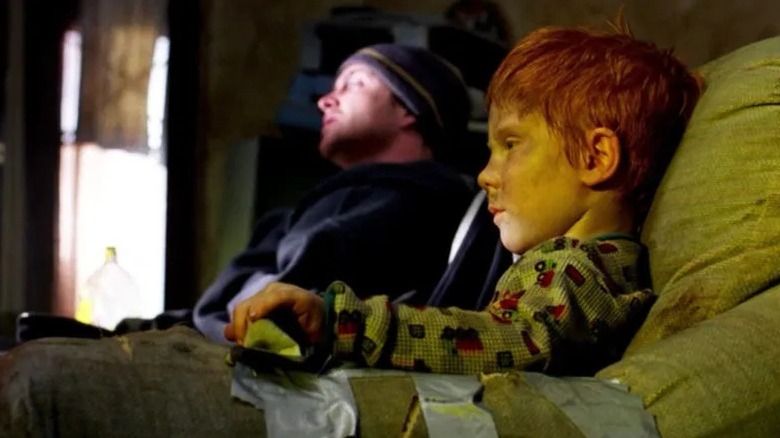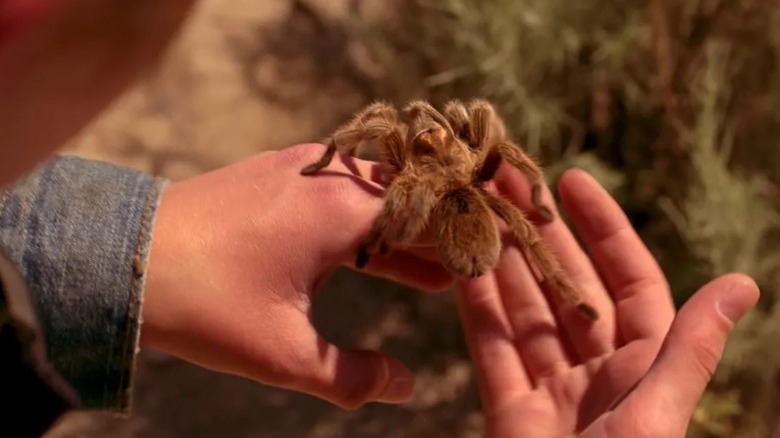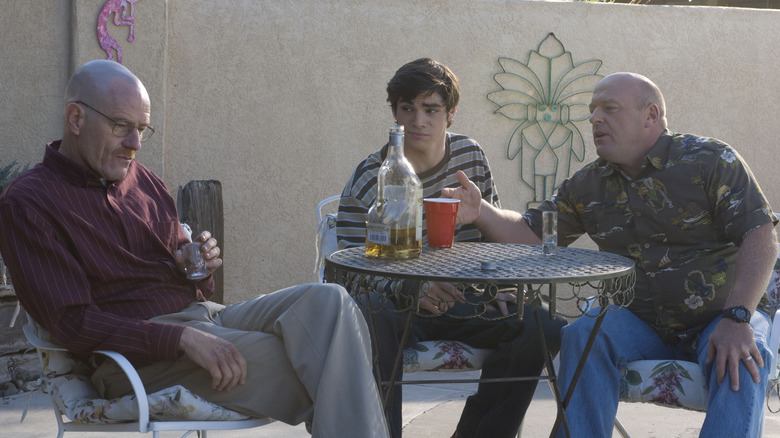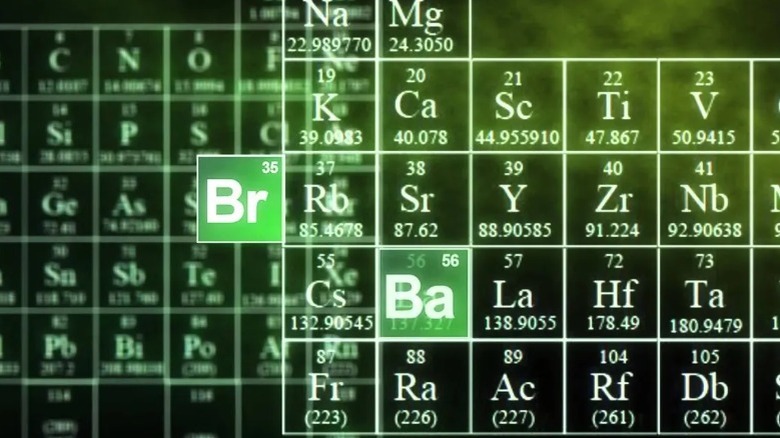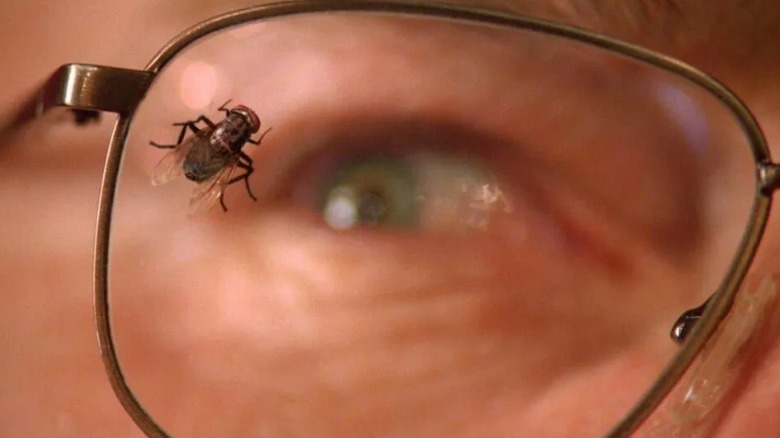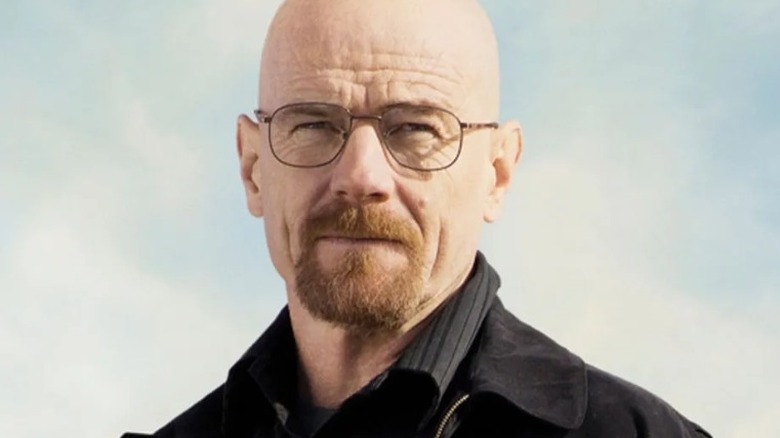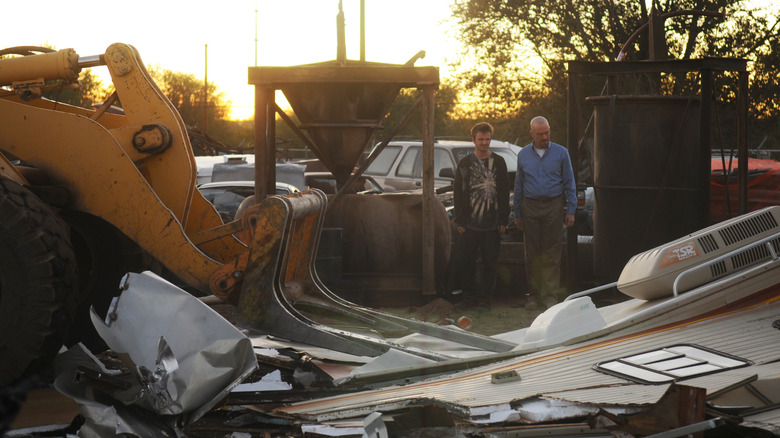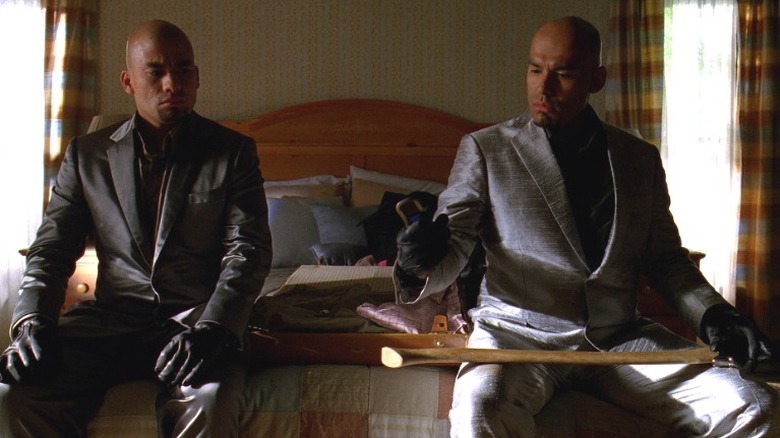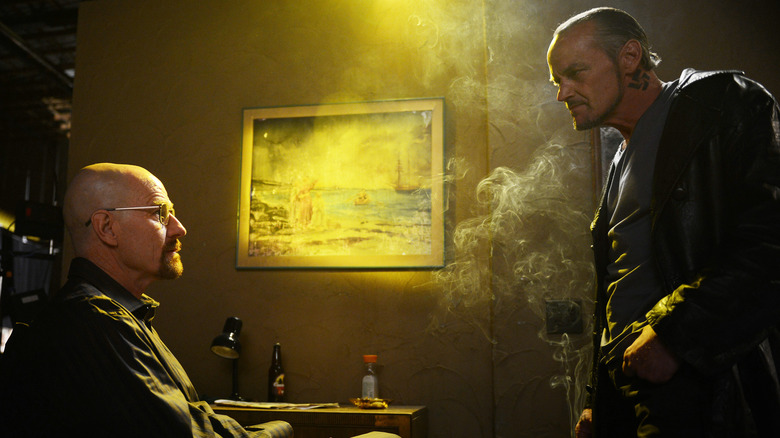12 Brilliant Ways Breaking Bad Uses Symbolism To Tell Its Story
Vince Gilligan's masterpiece "Breaking Bad" is an artistic take on the world of drugs and throws light on what a talented man pushed to the edge can do. Starring Bryan Cranston as Walter White and Aaron Paul as Jesse Pinkman, "Breaking Bad" follows Walter, a high school chemistry teacher whose terminal lung cancer diagnosis turns him toward building a meth empire and transforms him into a sought-after drug lord, all in an effort to leave money behind for his family ... initially, at least. The series ran for five glorious seasons on AMC and spawned the spinoff "Better Call Saul" as well as the movie "El Camino."
"Breaking Bad" is known for its brilliant characters, amazing storytelling, and various symbols, imagery, and motifs that foreshadow events or help explain what remains unseen to the naked eye. One of the most crucial symbols in the entire series is the adept use of colors and how it reflects the personalities of the characters. However, there are several more symbols that help tell the story, without uttering a single word. Below are the 12 brilliant ways "Breaking Bad" uses symbolism to narrate a story about drugs, greed, death, and family.
Pants
When you sit down to watch "Breaking Bad" for the first time, the first visual you're greeted with is rough, barren terrain with jagged hills in the middle of a desert, and a pair of trousers flying in the air, before they are run over by an RV driven by a frantic man. He's wearing only underwear and a gas mask, while another man who is also fitted with a mask is passed out on the passenger seat. Two dead bodies slide across the floor of the RV. With so much going on, you don't pay much attention to the pants, but it immediately sets the tone of the situation you're watching.
The flying pants symbolize the heavily chaotic situation that the RV driver, who is revealed to be Walter, finds himself in. He pulls out a gun from the vehicle and points it at an oncoming danger. Just like this scene, Walt's personal life is in tremendous chaos — he's a chemistry genius stuck in a dead-end teaching job and battling with deadly lung cancer. The flying pants symbolize everything that's gone wrong and how it's beyond his control.
The pants make a reappearance in the final season, lying in a heap in the desert, as Walt rolls a barrel loaded with cash by it. Chaos has once again descended in his life, and he doesn't see a way out of it. A recurring theme in the show, the trousers represent disorganization and disarray.
The pink teddy bear
How often have we visited a child's birthday and carried a teddy bear as a gift for the kids? We usually associate teddy bears with children's playthings, a far cry from the death and destruction that "Breaking Bad" brings. However, in the opening scene of Season 2, Episode 1, "Seven Thirty-Seven," a partially burnt pink teddy bear can be seen floating in the Whites' swimming pool. Upon closer inspection, one of its eyes is missing — we can only guess what became of the toy's owner.
The toy bear makes several appearances in the opening vignettes throughout Season 2, as it heavily foreshadows the fate of a key antagonist. In Season 4, Episode 13, "Face Off," Los Pollos Hermanos manager and narcotics distributor Gustavo "Gus" Fring (Giancarlo Esposito) dies in the exact way that was hinted back in Season 2. Thanks to the burning hatred of the patriarch of the Salamanca gang, Hector (Mark Margolis), coupled with the diabolical genius of Walter, Gus has half of his face blown off, complete with a charred eye socket. The teddy bear's eyeless, half-burnt face is one such prop that mirrors the way Gus goes down.
Damage to the eyes
The eyes are said to be the window to the soul, and if the eyes cannot see, the soul is left to dwell in darkness. A similar situation is seen repeatedly with the characters in "Breaking Bad" where their eyesight is hampered or damaged, Jesse being the biggest example. On several occasions, he sports a completely shut or bruised eye because of the several beatdowns he takes, which heavily impacts his vision. This damage to his eyes signifies how he's unable to see the error of his ways and how his being a part of the drug business is ruining the lives of people around him. Although much kinder at heart than most other characters in the show, Jesse is blinded by external factors that keep him chained to this world of crime.
Walter on the other hand, intentionally chooses to ignore the death and destruction that he leaves in his wake, and this is reflected when he decides to argue with a policeman in Season 3, Episode 2, "Caballo Sin Nombre." While driving with a fractured windshield, damaged by the falling debris from the plane, he's stopped by police. He decides to argue and is pepper sprayed in the eyes, virtually blinding him for a few minutes.
The beetle
Time and again, Jesse's inner kindness has revealed itself, even when the character is in extreme pain and duress. In Season 2, Episode 6, "Peekaboo," Jesse lays his finger out to help a beetle on its way, instead of killing or ignoring it. This tells us about his unwillingness to kill something, no matter how insignificant it might be. His friend Skinny Pete (Charles Baker) is a lot less kind and squashes the bug as soon as he sees it. Later, Jesse breaks into a house to reclaim what some junkies — Spooge (David Ury) and an unnamed accomplice (Dale Dickey) — had robbed Pete of and finds a young boy (played by Dylan and Brandon Carr).
Not only does Jesse prepare food for the child, who looks haggard and unkempt, but also plays peekaboo with him to keep him entertained. Toward the end of the episode, Jesse calls 911, carries the child outside, and says, "You have a good rest of your life, kid," before leaving. Any other person in this business wouldn't have cared about the child of meth addicts who had stolen money from them, much less prepared food for him. Be it an insignificant beetle or a child, Jesse was the most humane character in a world that lived by the kill-or-be-killed motto.
The tarantula
"Breaking Bad" takes place mostly in Albuquerque, New Mexico, with its vast stretches of the desert being a recurrent presence throughout the series. Such deserts are home to innumerable creepy crawlies, including the dangerous tarantula. Season 5, Episode 5, "Dead Freight," opens with a kid getting off his bike to pick up one such tarantula and put it in a glass jar. The kid, Drew Sharp (Samuel Webb), unfortunately, shows up at the spot where Walt, Jesse, and Todd Alquist (Jesse Plemons) have just completed their methylamine heist and are celebrating. Drew waves at the three men, and while Walt and Jesse are dumbfounded, Todd waves back with a smile and then shoots him dead.
Todd is a sociopath, as is clear from his actions. Toward the end of the episode, it's revealed that he had picked up the caged tarantula from Drew. The tarantula within the glass jar is an innocuous object that cannot harm anybody and symbolizes the weakening foundations of Walt's drug empire and he's as helpless as the spider. Like the tarantula is restricted, Walt has nowhere left to run as his enemies keep increasing and the DEA gets ever closer to apprehending the man who hides behind the mask of Heisenberg.
Swimming pools
Barbecues around the swimming pool on Sundays are the perfect get-togethers for friends and family. However, in Vince Gilligan's world, swimming pools are one of the most frequently used settings to establish the anarchy that keeps steadily increasing for five seasons. The Whites' swimming pool is featured many times — in Season 2, Episode 10, "Over," it's the backdrop of an altercation between Walter and Hank (Dean Norris) when Walt forces his son Walt Jr. (RJ Mitte) to drink alcohol.
In Gilligan's yellow-tinged land of Mexico, the swimming pool is a common presence in the cartel's boss Don Eladio's (Steven Bauer) mansion, as all of the business transactions happen by the pool. In a flashback, Gustavo's business partner Max Arciniega (James Martinez) is shot dead by Hector and his blood reddens the waters of the pool. The dead body of Don Eladio floats in the same pool years later after Gus makes him drink poisonous tequila, finally exacting his revenge. Usually known as a spot that brings people together, the pool becomes the backdrop of families breaking apart and death. It also serves as the mirror to man's guilt and when one can't suppress the guilt any longer, they try making the pool their watery grave — like Skylar (Anna Gunn) in Season 5, Episode 4, "Fifty-One."
The 62nd element
The series is full of hidden imagery and symbols that even the most eagle-eyed fans need to look twice to identify. One such instance can be found within the periodic table, part of which we see in the show's opening credits. Interestingly, the 62nd element of the table, known as Samarium, has a key role in the show. Samarium is used to treat lung cancer, the primary reason that Walt decides to turn to the drugs business in the first place.
Additionally, the theme of 62 can be found again if we take note of the number of episodes in the show. There are 62 episodes in total in the series, and it ends with Walter's death. Of course, his fate was already sealed because of his cancer diagnosis, but he actually dies from a bullet wound and leaves behind a ruined family and several dead bodies.
The fly
An entire episode is dedicated to this symbol, a pesky fly that can't be caught nor killed despite the repeated efforts of Walt in Season 3, Episode 10, "The Fly." The insect flies into a meth lab and disrupts Walt's cooking procedure which results in him getting increasingly frustrated and attempting to kill the contaminant. He throws his shoe at the fly and breaks a lamp, falls off the catwalk, and is still unsuccessful. You could dismiss this as the chemistry genius' dedication to perfection and flawlessness, but as the episode progresses, it hints at something darker. Walt reveals that he regrets what his life has come to and he wishes he had died much earlier.
Walt knows he will die, be it from his worsening lung cancer or because of the criminal activities that have made him significantly richer as a cruel drug lord. The fly represents the constant reminder of Walt's oncoming doom and also the guilt that he's carrying around. In his dazed and sleepless condition, Walt associates the fly that has contaminated the lab with his overbearing guilt and cannot rest until he swats the pest.
The bald heads
Kelly Nelson, the hair stylist for "Breaking Bad," gets a lot of flak online because most of the male characters in the show don't sport glossy and flowing hair. Instead, they either have a shiny bald head or a buzzcut. However, this hair styling, or the lack thereof, is an intentional move. Characters like Walter and Jesse start the show with a full head of hair, but as the series progresses, their hair reduces. At the beginning of the show, they are harmless and docile people, breaking the occasional rule, but living within the moral compass of life.
Walter has to shave his hair off because of his cancer treatment, but even afterward, he maintains a bald head. He shaves his head with a clenched jaw and completes his transformation from the unassuming and frightened man with a mid-life crisis to one of the greatest drug lords. Likewise, when addicts and crackheads start living with Jesse, he shaves his hair to imitate them. This decision for a haircut is a calculated move to reflect the hardening of the heart. Jesse is no longer the peekaboo-playing young man and has the blood of an innocent on his hands. He accepts his life as a murderer and the shaven head reflects this transformation.
The meth RV
The first time we see the RV is when Walt is driving it down the desert path in his underwear and crashes it in a ditch in Season 1. Over the first few seasons, the RV becomes a hideout and a space of its own to cook meth away from the public eye. Even when they're stuck in the middle of nowhere without water, Walter and Jesse are not under the thumb of a bigger power. This all changes when Walt and Jesse begin working under Gus Fring. Sure, they earn a lot more money than they would by cooking in a recreational vehicle, but trading in freedom and safety for a bigger paycheck can never be good. The vehicle represents the freedom to choose and the independence to lead one's life the way one wants, while the underground meth lab, albeit a multi-million dollar operation, is a gilded cage.
Walt and Jesse realize the value of the RV all too well when they watch the vehicle being totaled at the scrapyard. We see the last of the vehicle in Season 3, Episode 6, "Sunset," as it is crushed under a hydraulic press, symbolizing the crumbling structure of the operation that Walt and Jesse had led. After the RV is gone, the men are robbed of their freedom, and forced into a strict regime of 9 to 5, with the only exception being that an error in this business leads to certain death.
Teddy bear's missing eye
Symbols are aplenty in the show but one of the strongest and in-your-face symbols throughout the series is the missing eye of the aforementioned pink teddy bear. Upon accidentally finding the eye, Walter chooses to keep it when a normal man, knowing what the eye belonged to, would have burnt it or at least thrown it away. However, Walt decides to keep it in his drawer, and it forms one of the strongest symbols.
It's supposed to remind him that no matter how well he covers his tracks, he's being watched, and this can either relate to the cameras that Mike Ehrmantraut (Jonathan Banks) installs in his house or the fact that he survives what would have resulted in his certain death. In Season 3, Episode 2, "Caballo Sin Nombre," the Salamanca twins (Daniel and Luis Moncada) are sitting in Walt's bed with an ax waiting for him to step out of the shower when one of them picks up the eye. Immediately, they get a text message from Gus asking them to stand down and meet him at Los Pollos Hermanos. The plastic eye can be interpreted as an all-seeing eye that protects Walter until his number is finally up.
The painting
This painting makes two appearances in "Breaking Bad," and it serves as one of the myriad of symbols that litter the show. The painting shows a man rowing away in a small boat, as a family of three stands at the beach, and the mother waves at the man. One of the times we see the painting is in Season 5, Episode 8, "Gliding All Over," when Walter returns from his fugue state and is once again at Uncle Jack's (Michael Bowen) place who explains how some planned prison murders will be orchestrated. Walt isn't interested and stares deeply into the painting, which seems to reflect his own life.
A man is rowing away from the comfort and love of his family to strange and unkind waters, unknowing of what lies beyond. This relates to Walt, who has abandoned his family and is pursuing what he considers greatness. Of course, he terms it as "providing for [his] family" but as he admits to Skyler at the end of Season 5, he built his meth empire because he felt alive while cooking meth: "I did it for me." Just like the man in the painting rowing toward a bigger ship, Walt steamrolled his way into the world of drugs, so he finds himself in the painting, however, all alone in unknown waters.
